The EconoNorse Iron Smelter
The EconoNorse small test smelter takes its rough size and general operating characteristics
from a blend of Viking Age archaeology and modern practical experience. The rough
form was developed in Fall of 2004 by members of the Dark Ages Re-Creation Company, with further refinements made in February of 2005 with guidance from Sauder /
Williams / McCarthy.
Past experience has shown that the smelter team ideally should consist of at least
THREE individuals, with an additional person as record keeper. Charcoal and ore should
be prepared before the actual smelt.
The basic structure is made up of three circles of standard fire bricks set above
one another, with eight fire bricks stood on end making each layer (for a total of
24). This gives an internal size roughly 10" / 25 cm in diameter and about 24" /
60 cm high. The bricks are contained inside a support structure made of a cylinder of sheet
metal (or leaning stone slabs) about 24" / 60 cm in diameter. The gap between these
two is filled with a loose mix of wood ash and sand (or other insulating material).
The internal floor of the smelter should be built up to a depth at least 2" / 5 cm
deep with a tamped down mixture of wood ash and charcoal dust. A gap in the first
layer of bricks should be constructed about the size of a single brick laying horizontal
to form at tap arch. If the whole structure is constructed on plinth of bricks containing
a built up layer of sand / ash / charcoal fines, the slag tapping process is made
easier.
The tuyere (air inlet) can be made of a simple length of 1 or 1.25" OD / 2.5 to 3
cm standard schedule 40 (or standard black threaded) steel pipe.It is placed on top
of the first layer of bricks, in a small gap in the second layer - at 90 degrees
to the tap arch. Above the tuyere, this gap should be filled with part bricks and sealed with
clay. The tuyere should protrude about 2" / 5 cm inside the smelter wall (B). It
should be positioned on a slight down angle of roughly 20 - 25 degrees (C), and stabilized with a spare brick or wood block. The shape and quality of the bloom is greatly
effected by the position of the tuyere.
Air flow can be provided by a old vacuum cleaner blower, great bellows or hand rotary
blower. If an electric blower is used, it should be equipped with either a sliding
plate air valve or adjustable motor speed control. The air volumes required are considerable, and must be delivered both constantly and consistently over the entire smelt.
Air flow is a variable related to smelter diameter, and for this size will be approximately
600 - 800 l/min.
|
At Smeltfest 05
|
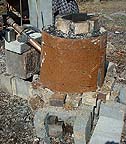
|
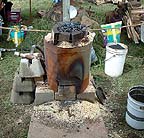
|
OABA 05
|
A huge quantity of regular hardwood charcoal will be consumed during the smelt, normally
from 150 to 175 lbs / 70 - 75 kg. This should be broken up and then screened so that
no pieces are larger than 1" / 2.5 cm dia. (walnut) and smaller than .5" / 1 cm
(pea). The fines are used as insulating material.
Iron ore may be natural rock, bog ore or prepared taconite. In any case the iron
oxide ore must be pre roasted by heating to glowing (it will become magnetic after
this step). The roasted ore must be crushed when cooled so that bulk of the particles
run between rice grain and no larger than pea sized. It has been fund that quenching
the hot ore (rock or taconite) assists in this process.
The smelter should be preheated, starting with softwood splits and no air blast. The
fire size plus air blast will be increased over about a one hour period. At this
point the first load of unsorted charcoal is made, with graded fuel used after. As
temperature inside the smelter increases, both the consumption rate will increase, and the
position of the observable top to the burning zone will rise. The smelter will be
approaching operating temperature when the time to consume a standard galvanized
pail (at roughly 4 lbs / 1.75 kg) is about 10 minutes and the burning zone approaches the
top of the fire bricks. Fuel should heap up over the top of the smelter and added
whenever the level drops to even with the top edge. Note that this consumption of
fuel should remain relatively constant throughout the remainder of the smelt. This is the method
used to determine changes in air flow or rate of adding ore charges.
Operating temperature should be arrived at after about 30 minutes and the first 'seed
charge' of roughly .5 lbs /.22 kg is added by sprinkling evenly over top. This should
be repeated with every fuel charge for about the next four. It is suggested that
a standard sized long handled scoop be used for this. Note that various ore types will
have different volumes to achieve the weight.
About one hour into the smelt, the smelter should 'take off' with consumption rates
rapidly increasing. The consumption rate can be stabilized by increasing the amount
of ore added per fuel charge to maintain the consumption times, typically increasing
by .5 lb / .22 kg amounts. Normally the consumption rate will peak with ore charges
in the range of 3 to 3.5 lbs / 1.5 - 1.75 kg.
|
Pre-heat Phase
|

|
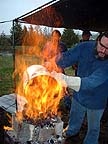
|
Adding Charcoal Charge
|
About four hours into the smelt, The process of tapping off slag typically will begin
about four hours into the smelt. The rate and volume of slag will vary due to ore
type, but a balance must be made between maintaining a bowl of liquid slag - and
not 'drowning' the tuyere. Tapping is done by removing the brick blocking the tap arch,
then digging away the loose material to expose the bottom of the slag bowl. Typically
a rod is used to pierce the solid bowl through to the liquid slag above. Returning
tapped slag to the top of the smelter effectively recycles iron still embedded in the slag
into the growing bloom. It also is a way to lower the position of the developing
slag bowl to keep the tuyere clear. If there is a
large volume of slag, but it is too viscous to easily run, a small amount of forge
scale can be added with the charges.
Just how long the sequence of adding ore charges should continue will depend on just
how large a metallic bloom is desired. The EconoNorse Smelter has successfully produced
blooms as small as 3 kg / 7 lbs, with 7 - 8 kg / 15 - 18 lbs being common. Generally, at a point ranging from 5.5 to 6 hours into the smelt, addition of ore charges
should be stopped. A further 3 - 4 fuel charges should be added, then air flow should
be somewhat reduced and the remaining charcoal be allowed to burn down. At this
point the bloom mass can be extracted via the tap arch, out of the top of the smelter,
or (easiest with brick construction) by tearing the walls down. Be aware that the
heat is intense!
Primary consolidation of the bloom can be undertaken using the residual heat of smelting.
If care is taken with dismantling the smelter, it now can be operated as a large
forge for further compression of the bloom mass. Typically the original foot ball
shape of the bloom is hammered to a hockey puck - a shape found with artifact blooms.
|
Tapping Slag
|
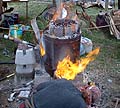
|
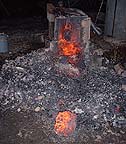
|
Smelter Walls Dismantled
|
Total charcoal consumed +/- : 70 - 75 kg / 150 to 175 lbs
Total ore added +/- : 13 - 25 kg / 30 - 60 lbs
Bloom expected +/- : 3 - 7 kg / 7 - 15 lbs
Exact yield dependent on ore purity (from 25 - 35%)
Exact carbon content of the metal is related to a large number of variables over the
smelting sequence!
DARC would like to thank the continuing support of

Text, Illustrations and Photographs © Darrell Markewitz - 2005
Web design by Darrell Markewitz